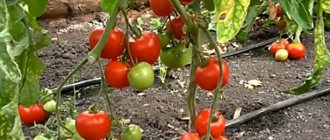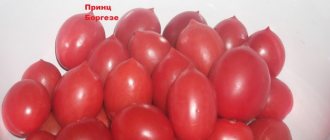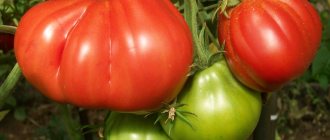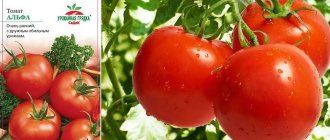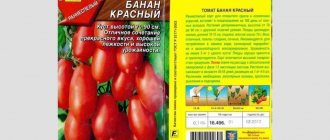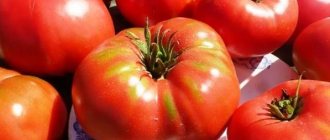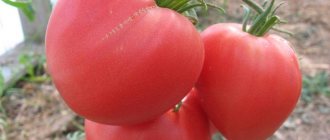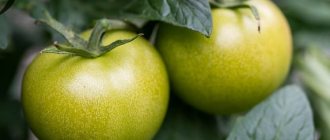Description of the tomato variety “Seedless”
| Variety name | Seedless |
| general description | Early ripening, determinate variety of tomatoes for growing in greenhouses and open ground |
| Originator | Russia |
| Ripening period | 100-110 days |
| Form | Round |
| Color | Red |
| Average weight of tomatoes | 100-110 grams |
| Application | Universal |
| Productivity of the variety | 8 kg per square meter |
| Features of cultivation | Grown without seedlings |
| Disease resistance | Needs late blight prevention |
- The seedless tomato is a determinate variety. Not a hybrid. The seeds of the variety are suitable for collection and subsequent use.
- The foliage is average, the bush has few branches. Bush height up to 40 cm.
- Refers to early varieties, the period of fruit ripening is 100-110 days after emergence.
- It is grown in open ground, light film shelters, and in greenhouses.
- The first inflorescence is formed above the 6-7th leaf. 6-8 fruits are formed in the brush.
- The fruits of the seedless tomato have a pronounced, even red color, without a spot at the stalk. Round shape. Fleshy. Fruit weight 100-110 g.
- It ripens well and is easy to transport.
- The keeping quality of the variety is high.
- A universal table variety, good taste, used for canning and pickling. The taste is sweet, with a pronounced tomato aroma.
- Productivity is high.
The “Bezrassadny” tomato variety was created on the basis of frost-resistant and soil-resistant tomatoes from the Soviet breeder Pavel Saraev. Zoned in the southern and central regions of Russia, Moldova and Ukraine. Suitable for risky farming areas.
Amateur vegetable growers receive good harvests of the seedless variety in Komi, Karelia, Pomorie, in the northwestern regions of Russia, Siberia, and the Urals.
The yield of other varieties is presented below:
| Variety name | Productivity |
| Seedless | 8 kg per square meter |
| Apparently invisible | 12-15 kg per square meter |
| American ribbed | 5.5 kg per bush |
| Apples in the snow | 2.5 kg per bush |
| King of the Market | 10-12 kg per square meter |
| Early love | 2 kg per bush |
| The president | 7-9 kg per square meter |
| Samara | 11-13 kg per square meter |
| Nastenka | 10-12 kg per square meter |
| Baron | 6-8 kg per bush |
| Yablonka Russia | 3-5 kg per bush |
Tomato care
Tomatoes without seedlings are cared for correctly; they require more attention from the gardener. In a greenhouse, control of light, humidity and air temperature comes first. In hot weather, fruit set will be poor.
In open ground, you must not overdo it with watering and fertilizing.
Stepsoning
For indeterminates, it is important to remove stepchildren. After breaking off the bushes, fresh places where the shoots were removed are sprinkled with activated carbon or treated with Bordeaux mixture.
For low-growing tomatoes, pinching is not necessary. If there are a lot of stems, then you can remove some of them.
Irrigation and fertilizing of bushes
Water tomato bushes sparingly. This is especially true for greenhouse plants. Increased soil moisture will become a source of development of pathogenic fungi.
Tomatoes are fed every 12-14 days, first with organic fertilizers. To do this, water with a solution of chicken manure in a ratio of 1:12 or mullein - 1:6. As the plants grow, fertilizers containing phosphorus and potassium are applied. Substances are needed for better flowering and fruiting of vegetable crops.
Shaping and garter
Bushes are formed by pinching. Tall ones need to stop developing in time, so the top of them is pinched, leaving 2-3 leaves above the top tying brush. Also, long stems require garter. For this purpose, trellises are built in the greenhouse, and pegs are stuck in the street next to the tomato stem.
Determinants rarely require bush formation. Only those that are very spreading will have to say goodbye to part of the stems.
Advantages and disadvantages
The advantages of the variety include:
- Non-seedling cultivation, low production costs.
- Powerful root system, ecological plasticity.
- Increased resistance to diseases: late blight, blossom end and root rot.
- Drought and frost resistance, abundant fruiting, high commercial quality.
Among the disadvantages can be noted:
- Later than tomatoes planted with seedlings, ripening.
- Fruiting time is reduced by 25-30 days.
Sowing tomatoes in a greenhouse, hotbed, under film cover
Many gardeners notice this paradox: the later you sow tomatoes, the faster they grow and produce a harvest. The February ones have just had time to adapt to the garden, but those that were sown in April have already caught up with them and bloomed earlier. In the middle zone, you can sow tomatoes in the ground from the second ten days of April. The best way is in a garden bed in a greenhouse, but if there isn’t one, it doesn’t matter, you can always find a way out.
Advantages of growing tomatoes without seedlings:
- no need to waste time, effort, and money on growing seedlings;
- the tomatoes are stronger and more resilient;
- plants do not stretch;
- hardened;
- quickly take root when planted;
- bear fruit until frost.
So, if we sow in a greenhouse, then we do the following:
- we draw grooves in the soil about one and a half centimeters deep;
- pour with warm water or a solution of potassium permanganate; sow the seeds - be sure to be dry! - and cover the top with coco-soil or ready-made soil for seedlings mixed with perlite;
- compact lightly.
If you don’t have a greenhouse, you can place arcs over the crops and cover them with agrofibre or polyethylene on top. And if the spring turns out to be cold, then you can build a low greenhouse in the greenhouse.
In such conditions, seedlings turn out strong, healthy, and hardy. In early June, it is transplanted into beds, covered with a layer of mulch, and fed with Baikal or herbal infusion.
Experience of sowing tomato seeds in warm holes
In areas further south, the process is further simplified. Here's what a gardener from Voronezh says about growing tomatoes without seedlings:
“In the spring, as soon as the snow melts, I prepare the holes. I make them at a distance of 40-45 cm from each other, pour a tablespoon of superphosphate into each and forget about them for two weeks. During this time, I buy tomato seeds of super-early and ultra-early varieties. Every year I grow time-tested “Ultra-early ripening F1”, “Kibits”, “Sanka”, “Golden Stream”.
Before sowing, I soak tomato seeds for half an hour in a slightly pink solution of potassium permanganate, then rinse them under running water and dry them. I sow 5-6 seeds of early varieties in each hole. I cover the top with greenhouses made from six-liter plastic bottles (I cut off the bottom), screw the lids tightly and wait for my crops to emerge from the ground. As soon as they hatch, I spray them with Baikal EM-1 solution once a week (pour a tablespoon into a bucket of water).
After two weeks, I leave two seedlings in the holes. Many people advise throwing away extra seedlings, but I’m sorry, there are not so many of them, and they are all the same in quality. I carefully pick it up with a tulip scoop with a good lump of earth and transfer it to the free holes. I water it, cover it with a greenhouse - and they continue to grow, as if they had sprouted right there.
After another week, I water the roots with an infusion of ash. Then I start opening bottle caps for the day. Then I take it off for a couple of hours, and soon I remove it completely, but at night I always cover it with spunbond.
A month later, my tomatoes are strong and the stems are thick. I always mulch the ground around them with rotted manure and straw: in the summer it’s hot here, you can’t set foot in the garden - the soles melt, and under the layer of mulch it’s always cool, and you have to water much less often.
At the beginning of August I pinch the tops of all the bushes. I spud up twice a summer. I spray it with garlic infusion against late blight, and with whey against blossom end rot. The harvests are excellent every year—you can’t even see the leaves under the tomatoes!”
The best varieties of tomatoes for growing without seedlings
Several varieties intended for cultivation in open ground (for central Russia):
- “Bullfinch” - super early, determinate, no more than 40 cm high. Fruits weighing up to 150 g, flat-round with slight ribbing, fully ripe - deep red in color, with dense pulp; pleasant moderately sweet taste.
- "Alpha" - super early, standard, up to 55 cm high, ideal for growing without seedlings. The fruits are small, weighing on average 50 g, round, red; The taste data is excellent. The only drawback is that they don’t last long. The variety is suitable for cultivation both in open ground and in greenhouses in the northern regions.
- “White filling” is an ultra-early ripening plant; the first fruits can be harvested already 80 days after germination. Bushes with a height of 50 (in open ground) to 70 (in greenhouses) cm. Fruits weighing more than 100 g, flattened, during the ripening period are similar in color to an apple of the same variety, fully ripe - bright red. The taste is wonderful! Gives a good harvest even in cold summers.
- “The Lazy Man’s Miracle” is a surprisingly productive variety, considering the height of the bush (less than half a meter) - up to 8 kg per square meter! Standard bush. There is no need to shape, tie or pin! The fruits weigh about 60 g, “cream”, and are red when fully ripe. Very pronounced tomato aroma, original taste - sweet, with slight sourness and slight spiciness. Universal use: can be eaten fresh, squeezed juice, canned, dried.
There are many other varieties that can be grown without seedlings without much hassle. All of them are distinguished by high yields, early ripening and excellent taste. Experiment too! You will definitely like it! And then, for sure, you will answer the question: what is the best way to grow tomatoes - from seedlings or without seedlings?
The “Bezrassadny” tomato variety was developed for industrial sowing of agricultural areas.
After successfully passing field tests, the variety is recommended for cultivation on a production scale and on the plots of amateur gardeners.
Features of agricultural technology
To disinfect, soak the seeds in a 1% solution of potassium permanganate for 15-20 minutes. Then it is dried until it flows. Before planting, it is worth treating the seeds with a growth stimulant, for example, Epin, Fitosporin, Zircon.
Vegetable growers use an aqueous solution of aloe juice or honey as natural stimulants. After stimulation, the seed material is left for two days to swell.
At the end of April, seed beds about 1.2-1.5 m wide are prepared. When digging, humus (rotted compost) is added - a 2 m² bucket, a small amount of ash. Draw two furrows 10-12 cm deep or make holes with a diameter of 20 cm.
Sprinkle with a weak solution of manganese and compact the soil. To better warm the earth, the beds are covered with film for a week.
When stable warm weather sets in, tomato seeds are placed in the ground. It is preferable to use areas after zucchini, cucumbers, carrots, cauliflower, dill, and parsley. Mulch with sand or peat. Don't water. They cover it again. Wait 7-10 days for sprouts to appear.
Read all about what soil is for tomatoes: for seedlings and adult plants in a greenhouse. And also, how to prepare the soil mixture yourself and what types of soil for tomatoes exist?
When the seedlings reach the height of the shelter, the film is fixed on frames and arches. To protect against possible frost, place plastic bottles of water in the aisles.
When the average daily temperature is set at 20°, the film is removed for the day. When the threat of returning subzero temperatures has passed, the shelter is removed completely. After the appearance of 3-4 true leaves, thin out, leaving up to 10 plants per 1 m².
Advice! To form numerous ovaries, foliar spraying with an aqueous solution of boric acid can be carried out.
The seedless tomato does not experience stress from transplanting or picking. Forms a root system that goes deep into the soil, thereby extracting more moisture than traditional seedling varieties. Watering is rare. Once every 7-10 days, with warm water. The variety is responsive to drip irrigation.
Tomatoes are fed with complex fertilizers twice a season. Nitrogen fertilizers are applied in the spring. For autumn tillage of the land, for subsequent plantings - potassium-phosphorus mixtures.
Tomatoes require regular weeding. Loosening after rains, watering, formation of a surface crust on the ground. Mulching. Hilling. The variety does not require gartering or pinching.
Advice! When autumn cold sets in, protect with covering material. Fruiting time will increase.
Read more about fertilizers for tomatoes:
- Yeast, iodine, hydrogen peroxide, ammonia, boric acid, ash.
- Organic, mineral, ready-made.
- For seedlings, when picking, foliar.
- TOP best.
Growing methods
The most basic thing to do before starting growing is to choose the land and site so that the plants have enough solar energy, fertilizers and moisture. It is important to know when to plant seedlings according to the lunar calendar.
It is best to plant in light soil with a high content of nutrients and moisture capacity. It is not necessary for groundwater to pass too close to the roots. The location of the unpaved area is also important. As already mentioned, plants love warmth, so it is necessary to choose beds in which enough light will pass through and there is a high probability of exposure to sunlight. Growing tomatoes in open ground is described at this link.
Therefore, it is better to grow tomatoes on the southeastern slopes, since the light exposure is greater than in other areas.
It is advisable to use soil on which cabbage was previously grown. Another important point in choosing a bed is choosing a place where the wind does not penetrate. It is forbidden to grow tomatoes next to the beds where potatoes are planted, as there is a high probability of transferring diseases and harmful insects from potatoes to tomatoes.
Preparing the soil before planting crops
The width of the beds and soil should be 60-80 centimeters, and it is better to fertilize the area with humus or ash.
Arcs and a polyethylene cover are attached along the entire length of the bed to protect from the wind. You also need to prepare glass jars or plastic bottles that are cut in half. They will subsequently shelter the young tomato sprouts. After all the procedures have been completed, you can begin sowing and subsequent care of the shrubs.
There are two types of sowing tomatoes - in open ground and in greenhouses.
Plant in open ground
The seedlings must be placed in the holes in a checkerboard pattern, at a distance of thirty centimeters from each other. When ripe, it is necessary to remove some of the bad leaves, properly water, ventilate and care for the bushes. Before sowing, the selected area must be filled with warm water or a hot solution of potassium permanganate.
Place 5 tomato seeds in the hole. They are immediately covered with earth.
Until the first fruits appear, it is not recommended to touch the beds. When opening seedlings, you need to pay attention to the weather conditions present. Since tomatoes do not like moisture and cold, it is better not to disturb them in such weather, otherwise there is a high probability of diseases and a poor harvest. It is better to open seedlings in warm and calm weather. It’s better not to rush here, but to act correctly.
After 90% of the seeds have formed, a couple of good bushes are usually left in the hole, and the remaining ones are transplanted or pulled out.
Growing a seedless variety in open ground.
Watering tomatoes must be done with caution, as they do not tolerate high humidity. Vegetable crops independently provide themselves with sufficient moisture.
Also, caring for shrubs has several rules:
- it is better to use early varieties of tomatoes when sowing;
- The formation of the first fruits may be 2 weeks later than for other vegetables.
In greenhouses
Most often, seedlings are best grown on a windowsill or in greenhouses.
The greenhouses are warm all the time, this allows the plants to be comfortable. Moisture in such greenhouses is also not allowed to pass through. Therefore, tomatoes are planted better in greenhouses than in garden beds.
Useful video
In conclusion, we suggest that you familiarize yourself with the “Besrassadny” tomato variety in the video.
And in the table below you will find links to articles about tomatoes of various ripening periods that may be useful to you:
| Super early | Mid-season | Mid-early |
| White filling | Black Moor | Khlynovsky F1 |
| Moscow stars | Tsar Peter | One hundred poods |
| Room surprise | Alpatieva 905 a | Orange Giant |
| Aurora F1 | Favorite F1 | Sugar Giant |
| Severenok F1 | La La Fa F1 | Rosaliza F1 |
| Katyusha | Right size | Em Champion |
| Labrador | Dimensionless | Sultan F1 |
Soil preparation
The bed for sowing tomatoes must be prepared in advance. If green manure grows on the site, embed them into the ground using a flat cutter or cultivator. If green manure has not been sown, add a bucket of compost or humus for every 1 square meter, since tomatoes need fertile, light soil. Then loosen the bed with a cultivator and water it with a solution of the Ekomik Urozhainy biological product, which contains beneficial microorganisms that accelerate the decomposition of organic matter and heal the soil.
To prepare a solution for soil treatment, add 100 ml of the drug to 10 liters of water at room temperature and mix. Water the soil a week before sowing at the rate of 3 liters of working solution per 1 sq.m.
After watering, cover the bed with black agrotextile so that the earth warms up faster. Beneficial soil bacteria and earthworms are activated under shelter in moist soil. As a result, the structure of the soil, its air and water permeability will improve.
